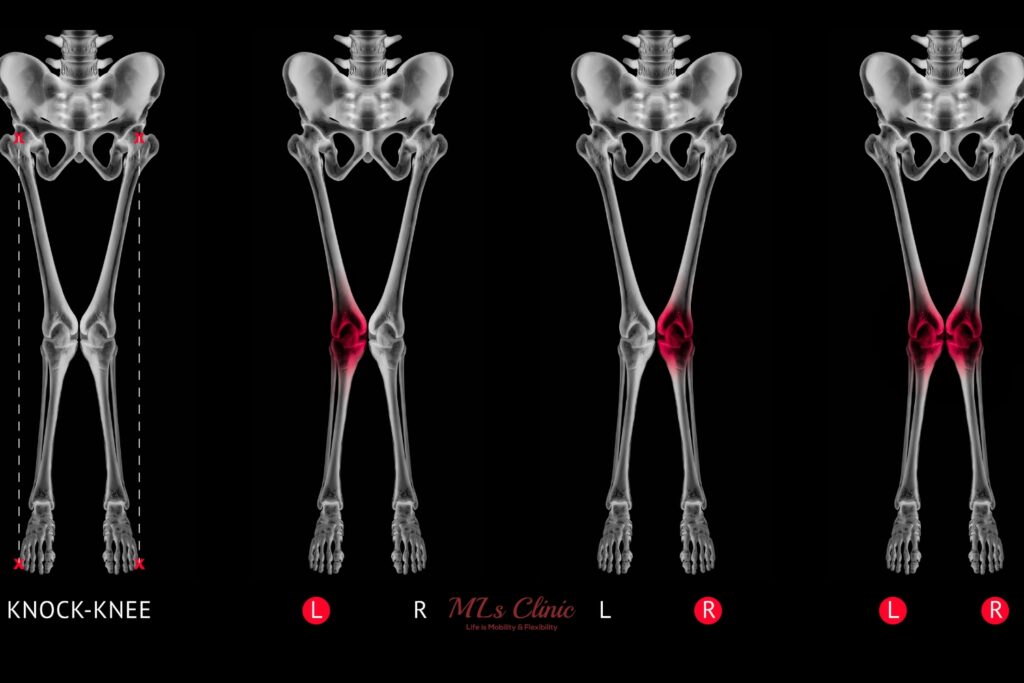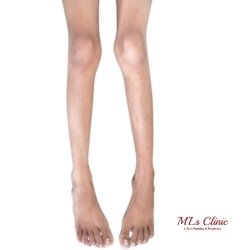Noticed Something Unusual About Your Knees? It Might Be Knock Knees!

Knock knees, or genu valgum, refer to a condition where the legs curve inward at the knees, making it difficult for the ankles to touch

without moving one knee ahead of the other. It is a common condition in children between the ages of 3 and 6 and generally improves naturally as they grow, without causing any issues. However, in some cases, older children or adults may also experience it.
To grasp this condition, it’s essential to first recognize what “normal” leg alignment looks like. In a typical alignment, when standing, the hips, knees, and ankles align in a straight line. This means that a line drawn from the hip to the ankle should pass directly through the center of the knee. If this line shifts outward past the knee, it indicates knock knees (valgus deformity). Conversely, if the line veers inward, this results in bowlegs (varus deformity).
What are the Types of Knock Knees?
Knock knees can be divided into two main types: Physiologic and Pathologic.
-
Physiologic Knock Knees
Physiologic knock knees are a normal part of growing up. It’s common for kids aged 3 to 5 to have this condition, with studies showing that up to 75% of them may experience it. Thankfully, for most children, the knee misalignment fixes itself as they grow, and their legs usually straighten by age 8.
2. Pathologic Knock Knees
Pathologic knock knees, however, are more severe and last beyond age 8 or can develop in adults. These cases are often linked to underlying health issues, such as obesity, vitamin D deficiency, calcium deficiency, arthritis, knee joint infections, or injuries.
What are the causes of knock knees?
Knock Knees (Genu Valgum) can be caused by various underlying factors. Knowing these causes is important for proper diagnosis and treatment. Here are some reasons that can lead to knock knees:
- Physiological Variation: Some degree of knock knees is normal in young children due to the natural alignment of their bones. It usually fixes itself as they grow.
- Rickets: This condition weakens bones because of a lack of vitamin D, calcium, or phosphate. It is more common in children and is often linked to poor nutrition or nutrient absorption.
- Osteoarthritis: This is a joint disease that can affect the knees, especially in older adults, potentially leading to knock knees.
- Blount’s Disease: This growth disorder affects the shin bone (tibia) and can cause severe bowing of the legs, resulting in knock knees. It is usually diagnosed in childhood.
- Osteochondroma: These are benign bone tumors that can interfere with normal bone growth, causing deformities like knock knees.
- Trauma or Injury: Injuries or fractures in the lower leg or knee can disrupt bone alignment, leading to knock knees.
- Congenital Factors: Some people are born with structural issues in their legs that can lead to knock knees.
- Obesity: Carrying excess weight puts extra stress on the knee joints, increasing the risk of developing knock knees.
- Connective Tissue Disorders: Conditions such as Ehlers-Danlos syndrome or Marfan syndrome affect connective tissues and can cause joint looseness, possibly leading to knock knees.
- Infection or Tumor: In rare cases, infections or tumors in the leg bones or joints can impact growth and alignment, causing knock knees.
What are the Symptoms of Knock Knees?
Knock knee syndrome is when the knees angle inward while standing with the feet together, but it doesn’t always show clear symptoms. Here are some common signs of knock knees to help you identify the condition and get professional help:
- Visible Inward Angling: You can see that the knees are misaligned when standing with feet together.
- Knee Pain: Pain is often felt on the inner side of the knee joint.
- Walking and Running Difficulties: In more severe cases, people may have trouble doing basic activities.
- Gait Abnormalities: Some may walk with a waddling or unusual gait.
- Joint Pain: Pain can also occur in the hips and ankles because of changes in alignment.
- Limited Range of Motion: Knock knees can make it hard to move the knees naturally.
- Discomfort During Physical Activities: Playing sports or being active can become painful or uncomfortable.
How do knock knees affect the knees, hips, and ankles?
Knock knees can cause the kneecaps to be out of place, leading to pressure and pain in the front of the knee. This misalignment puts extra stress on the outer side of the knee, often resulting in knee pain and potentially leading to arthritis. Knock knees can also affect hip movement, causing hip pain, which should be considered during corrective surgery. Additionally, the ankles may struggle to keep the foot flat, forcing them to compensate for the misaligned knees, which can lead to ankle pain.
Are knock knees normal?
Knock knees are a normal part of the growth process for most children. They usually straighten out naturally as children grow. However, if the problem continue after the age of six, are severe, or affect one leg more than the other, it may indicate a more serious issue like knock-knee syndrome.
Most children go through natural leg changes as they grow. They tend to be bowlegged until they start walking at around 12 to 18 months. By ages two to three, their legs angle inward, causing knock knees. By ages seven to eight, their legs typically straighten out.
If knock knees persist beyond these normal stages, it may be due to disease, infection, or other conditions. If the leg alignment worsens over time or only affects one side, an orthopedic specialist should evaluate the condition, and surgery might be needed for correction.
How to diagnose Knock Knees?
Knee specialist will check the patient’s medical and family history, along with any existing health issues. They will perform a physical exam of the legs and how the patient walks. To confirm the diagnosis, the orthopedic doctor may take standing-alignment X-rays or EOS images. These images show the leg from the hip to the ankle and help the orthopedic doctor identify the specific location and alignment of the deformity.
What are treatment options for Knock Knees in children & adults?
Knock Knees Treatment in Children
Most of the time, knocked knees don’t need treatment because they usually fix themselves as a child grows. Children can continue to be active, and there’s no need for special leg braces, shoes, or exercises. Mild knock knees that continue into adulthood typically don’t require treatment unless they cause problems like knee pain.
If knock knees are caused by another health issue, like rickets, treatment for that condition may be necessary, such as vitamin D and calcium supplements.
- Observation: In children, knock knees are often a normal part of growth and typically improve without intervention. Healthcare providers typically start by monitoring the child’s condition to see if treatment is needed.
- Physical Therapy: Physical therapy can be helpful for children with knock knees. Therapists can provide exercises to strengthen the muscles around the knees and improve alignment, as well as teach proper walking and standing techniques.
- Orthotic Devices: Sometimes, custom shoe inserts or orthotic devices are suggested for children. These provide support for the feet and help improve alignment while walking or standing.
- Bracing: In more severe cases that don’t respond to other treatments, a brace or knee orthosis may be prescribed. These are designed to gradually guide bone growth and correct alignment over time.
- Guided Growth Surgery: If knock knees persist and the child still has open growth plates, guided growth surgery may be an option. This surgery involves placing plates or screws to help direct bone growth towards a more normal alignment.
- Knock Knee Surgery: Surgery is rarely needed for knock knees, but it might be recommended if the condition is severe or doesn’t improve.
There are two main types of surgeries that can be performed:
- For children who are still growing, small metal plates are placed on the inside of the knees. These plates help guide their growth over about 12 months, and they are removed once the treatment is finished.
- For adults or children whose growth is complete, an osteotomy is done. In this procedure, the bone is cut at the point of the deformity and then realigned into the correct position. Screws and plates are used to secure the bones in their adjusted position. After an osteotomy, a patient can usually return to normal activities within a few months.
Knock Knees Treatment for Adults
There are several treatment options for adults with knocked knees:
- Physical Therapy: Therapy can help adults by improving muscle strength and joint stability. Therapists provide exercises and techniques that can relieve pain and improve alignment.
- Orthotic Devices: Custom orthotic insoles or shoe inserts can support the feet and help correct alignment for adults with knock knees.
- Weight Management: If being overweight contributes to the condition, orthopedic doctor may suggest losing weight and making lifestyle changes to reduce stress on the knee joints.
- Pain Management: Over-the-counter pain relievers, like nonsteroidal anti-inflammatory drugs (NSAIDs), can help manage knee pain and inflammation.
- Knock Knee Surgery: In severe cases where other treatments don’t work and the condition affects daily life or causes significant pain, surgery may be considered. Surgical options can include osteotomy (realigning the bone) or joint replacement for advanced osteoarthritis.
- Addressing Underlying Conditions: If knock knees are caused by another medical condition, like osteoarthritis or rheumatoid arthritis, it’s important to treat that condition as well.
If you suspect knock knees in adults or your child, consult Dr. Preetesh Choudhary, who is the best knee specialist in Indore for evaluation. Early diagnosis and appropriate treatment can prevent potential complications. Most children outgrow this condition naturally, but persistent cases may require further intervention to ensure proper alignment and function of the knees. The problem often resolve naturally; seek advice from orthopedic doctor if concerns arise for effective management and care.






